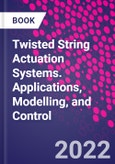Twisted String Actuation Systems: Applications, Modelling, and Control discusses the emerging area of twisted string actuation. It provides the basics of modeling and control, while also outlining the potential advantages of this actuation technique. Several detailed case studies describe the requirements and design parameters of the TSAs developed for different robotic applications. In addition, the book covers guidelines for engineers on the design and implementation of TSA in new areas and applications, discussing how to select strings with appropriate properties and suitable material, how to model actuators, and how to predict efficiency and lifetime.
The book will benefit the engineering community and increase the popularity of this promising novel type of actuator as it brings together the most up-to-date technologies and advances in the TSA field, along with their background and history.
The book will benefit the engineering community and increase the popularity of this promising novel type of actuator as it brings together the most up-to-date technologies and advances in the TSA field, along with their background and history.
Table of Contents
1. Twisted String Actuators: History and Background2. Mathematical Modelling of TSA
3. Design Guide
4. Control of TSA
5. Case Studies
6. Conclusion and Future Research
Case Study I: Precision Manipulation System
Case Study II: Upper-body Exoskeleton
Case Study III: Lower-body Exoskeleton
Case Study IV: Heavy Duty Manipulation System








